|
|
|
|
| 2022 |
2023 |
2024
|
1. Start 2025
|
2. In Autumn
|
3.
Castlemaine to Ceduna
|
|
|
|
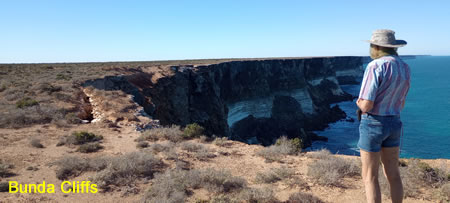 I
think everybody should have a chance to
travel across the Nullabor. For me, it does
lots of things. It certainly points out how
large Australia is - days and days of
driving and you still aren't there! It is
amazingly beautiful. I don't think it
matters how many times you see the cliffs of
the Great Australian Bight and peer off the
edge, it remains stunning. I
think everybody should have a chance to
travel across the Nullabor. For me, it does
lots of things. It certainly points out how
large Australia is - days and days of
driving and you still aren't there! It is
amazingly beautiful. I don't think it
matters how many times you see the cliffs of
the Great Australian Bight and peer off the
edge, it remains stunning.
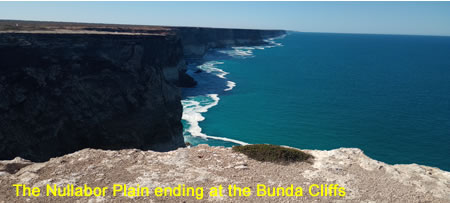
The Nullabor lives up to it's name on the
east side of the state border but literally
as soon as you enter WA, there are trees
again - stunted often, but trees
nonetheless.
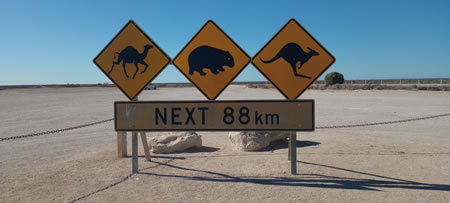
The Great Western Woodland is starting to be
talked about on brochures and tourist 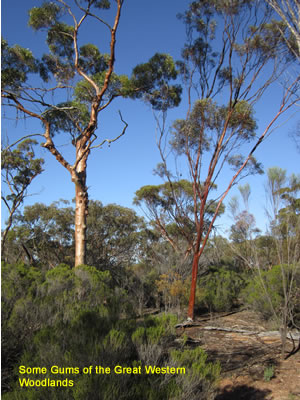 information
sites (and probably lots of other places)
but it hadn't entered my consciousness. This
woodland has lovely graceful trees with park
like open country between, sandy at this
time of year but covered with wildflowers
and heaths after the rains. It stretches for
an incredible distance, further than across
Western Europe; and like the tropical
rainforest has many, many different species
of plants and animals, insects and
birds, many not yet named by Europeans. At
the edges of the wheatbelt in WA where large
tracts have been cleared for cereal
cropping, I wonder what we have destroyed. information
sites (and probably lots of other places)
but it hadn't entered my consciousness. This
woodland has lovely graceful trees with park
like open country between, sandy at this
time of year but covered with wildflowers
and heaths after the rains. It stretches for
an incredible distance, further than across
Western Europe; and like the tropical
rainforest has many, many different species
of plants and animals, insects and
birds, many not yet named by Europeans. At
the edges of the wheatbelt in WA where large
tracts have been cleared for cereal
cropping, I wonder what we have destroyed.
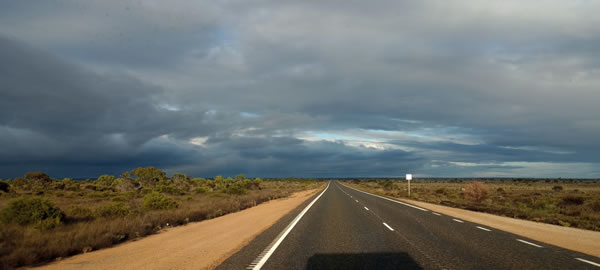 West
Australians often refer to themselves and "
the rest of Australia" as if we are
completely separate. When I think about how
the media report events in both places, I
can understand their sense of being ignored
by the eastern states. Who remembers the
bushfires of 3 years ago which burnt
millions and millions of hectares of the
woodland? Norseman was completely cut off
for 6 weeks and I wonder if it even
was reported in the east. You certainly
can't miss the size of the fire's impact
when you drive through it. West
Australians often refer to themselves and "
the rest of Australia" as if we are
completely separate. When I think about how
the media report events in both places, I
can understand their sense of being ignored
by the eastern states. Who remembers the
bushfires of 3 years ago which burnt
millions and millions of hectares of the
woodland? Norseman was completely cut off
for 6 weeks and I wonder if it even
was reported in the east. You certainly
can't miss the size of the fire's impact
when you drive through it.
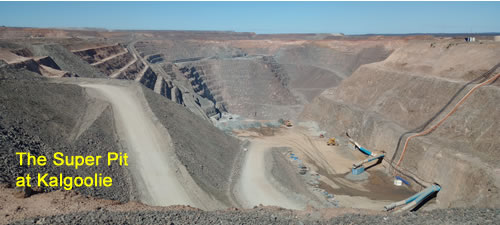
Likewise, I suspect I have an Easterners
understanding of the mineral wealth of WA.
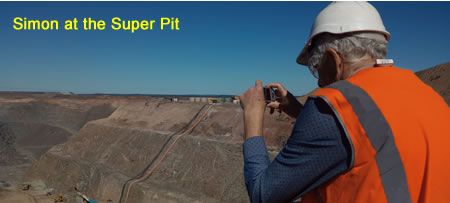
We visited Kalgoorlie and enjoyed three days
of walking, talking, visiting museums and
mines and even a brothel. Kalgoorlie is a "
family " town, which tries to minimise the
effects of "FIFO" mining, by requiring all
miners in the Superpit to live in town, it
has good schools and facilities and the
mines have poured back money into sports
fields, gardens, parks etc.
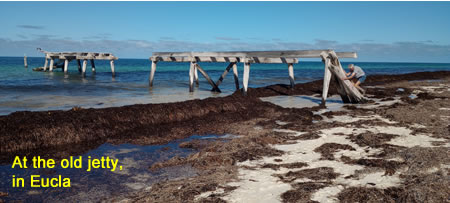
Then you notice the ore trucks, 3 and 4
truck road trains, and huge long rail
trains. You visit the super-pit , the huge
open pit mine in the golden mile, with
reputedly enough gold to keep mining for the
next 150 years. It is huge but it is not the
biggest and there are 25 such huge open pit
mines within 40 km of Kalgoorlie (or the
other way around, I am not sure). When we
were leaving, we stopped to empty our grey
water and I picked up a rock which looked
different to others on the verge. It
sparkles and is heavy and I need to borrow a
gold detector to confirm that it is really
gold bearing ore. (The samples we saw at the
superpit looked the same.)
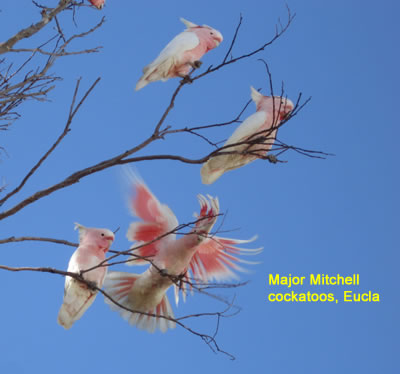
Early on, Kalgoorlie roads were made with
crushed rock presumed to be pyrites/fools
gold and later found to be the real stuff.
The roads were dug up, the surface treated
and the gold recovered.
We headed south to the coast after
Kalgoorlie. The beaches around Esperance win
"best 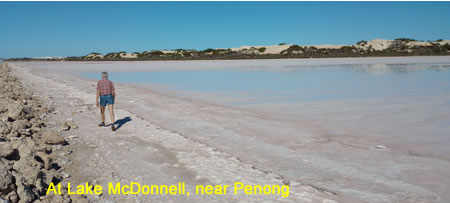 in
the world", "whitest sand", awards regularly
and deservedly. We are camped at Alexander
Bay, almost as far east as you can drive
without 4WD, and are only sharing it with a
handful of people. The sand is white, the
shallow water azure and the deeper water
deep blue. The breakers here curl and break
over the whole length of the beach and as we
walked for over 1 1/2 hours and were less
than halfway along, it is a huge bay. The
vegetation is quite different to Victoria
with hakeas, grevilleas and huge banksias
making in
the world", "whitest sand", awards regularly
and deservedly. We are camped at Alexander
Bay, almost as far east as you can drive
without 4WD, and are only sharing it with a
handful of people. The sand is white, the
shallow water azure and the deeper water
deep blue. The breakers here curl and break
over the whole length of the beach and as we
walked for over 1 1/2 hours and were less
than halfway along, it is a huge bay. The
vegetation is quite different to Victoria
with hakeas, grevilleas and huge banksias
making 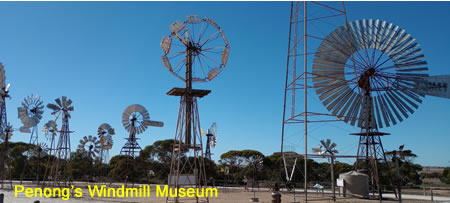 up
most of the trees. There is no light
pollution here and the stars are absolutely
incredible. The forecast is for rain from
tomorrow - I guess our run of blue
sunny days, short sleeves and shorts weather
couldn't last forever but it has been
delightful. up
most of the trees. There is no light
pollution here and the stars are absolutely
incredible. The forecast is for rain from
tomorrow - I guess our run of blue
sunny days, short sleeves and shorts weather
couldn't last forever but it has been
delightful.
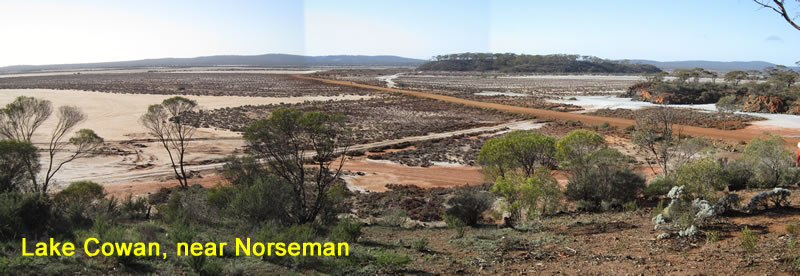
Tomorrow we start travelling west towards
the west coast.
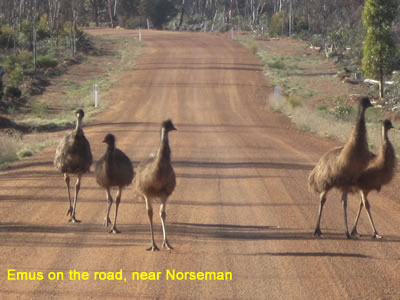
Simon's
Journal |
|
|
|
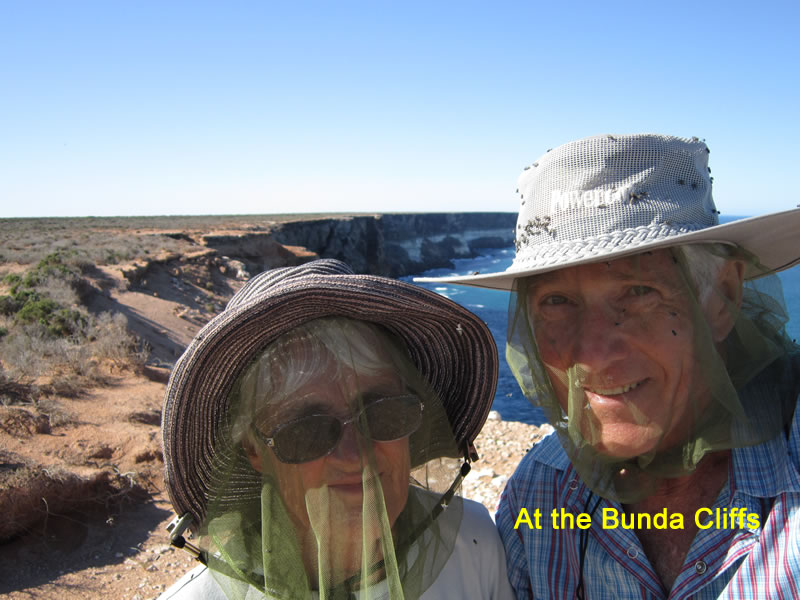
 I
think everybody should have a chance to
travel across the Nullabor. For me, it does
lots of things. It certainly points out how
large Australia is - days and days of
driving and you still aren't there! It is
amazingly beautiful. I don't think it
matters how many times you see the cliffs of
the Great Australian Bight and peer off the
edge, it remains stunning.
I
think everybody should have a chance to
travel across the Nullabor. For me, it does
lots of things. It certainly points out how
large Australia is - days and days of
driving and you still aren't there! It is
amazingly beautiful. I don't think it
matters how many times you see the cliffs of
the Great Australian Bight and peer off the
edge, it remains stunning. 

 information
sites (and probably lots of other places)
but it hadn't entered my consciousness. This
woodland has lovely graceful trees with park
like open country between, sandy at this
time of year but covered with wildflowers
and heaths after the rains. It stretches for
an incredible distance, further than across
Western Europe; and like the tropical
rainforest has many, many different species
of plants and animals, insects and
birds, many not yet named by Europeans. At
the edges of the wheatbelt in WA where large
tracts have been cleared for cereal
cropping, I wonder what we have destroyed.
information
sites (and probably lots of other places)
but it hadn't entered my consciousness. This
woodland has lovely graceful trees with park
like open country between, sandy at this
time of year but covered with wildflowers
and heaths after the rains. It stretches for
an incredible distance, further than across
Western Europe; and like the tropical
rainforest has many, many different species
of plants and animals, insects and
birds, many not yet named by Europeans. At
the edges of the wheatbelt in WA where large
tracts have been cleared for cereal
cropping, I wonder what we have destroyed.  West
Australians often refer to themselves and "
the rest of Australia" as if we are
completely separate. When I think about how
the media report events in both places, I
can understand their sense of being ignored
by the eastern states. Who remembers the
bushfires of 3 years ago which burnt
millions and millions of hectares of the
woodland? Norseman was completely cut off
for 6 weeks and I wonder if it even
was reported in the east. You certainly
can't miss the size of the fire's impact
when you drive through it.
West
Australians often refer to themselves and "
the rest of Australia" as if we are
completely separate. When I think about how
the media report events in both places, I
can understand their sense of being ignored
by the eastern states. Who remembers the
bushfires of 3 years ago which burnt
millions and millions of hectares of the
woodland? Norseman was completely cut off
for 6 weeks and I wonder if it even
was reported in the east. You certainly
can't miss the size of the fire's impact
when you drive through it. 



 in
the world", "whitest sand", awards regularly
and deservedly. We are camped at Alexander
Bay, almost as far east as you can drive
without 4WD, and are only sharing it with a
handful of people. The sand is white, the
shallow water azure and the deeper water
deep blue. The breakers here curl and break
over the whole length of the beach and as we
walked for over 1 1/2 hours and were less
than halfway along, it is a huge bay. The
vegetation is quite different to Victoria
with hakeas, grevilleas and huge banksias
making
in
the world", "whitest sand", awards regularly
and deservedly. We are camped at Alexander
Bay, almost as far east as you can drive
without 4WD, and are only sharing it with a
handful of people. The sand is white, the
shallow water azure and the deeper water
deep blue. The breakers here curl and break
over the whole length of the beach and as we
walked for over 1 1/2 hours and were less
than halfway along, it is a huge bay. The
vegetation is quite different to Victoria
with hakeas, grevilleas and huge banksias
making  up
most of the trees. There is no light
pollution here and the stars are absolutely
incredible. The forecast is for rain from
tomorrow - I guess our run of blue
sunny days, short sleeves and shorts weather
couldn't last forever but it has been
delightful.
up
most of the trees. There is no light
pollution here and the stars are absolutely
incredible. The forecast is for rain from
tomorrow - I guess our run of blue
sunny days, short sleeves and shorts weather
couldn't last forever but it has been
delightful.
